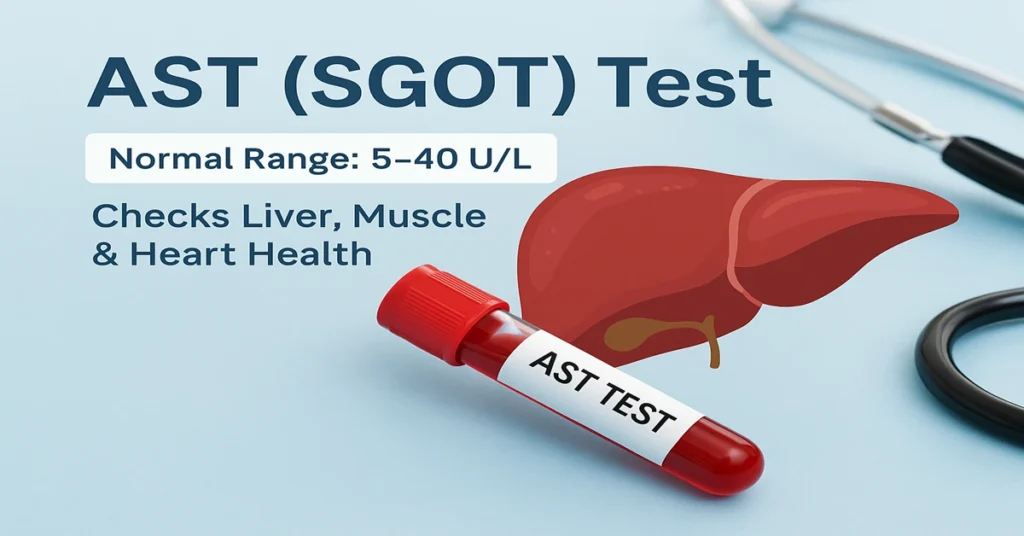What is AST (SGOT)?
AST, also called SGOT (Serum Glutamic-Oxaloacetic Transaminase), is an enzyme found in many body tissues. A blood test measuring AST levels is commonly used to check liver health, muscle injury, and sometimes heart function.
When the liver, muscles, or heart are damaged, AST leaks into the blood. That’s why high AST levels often point to problems like liver disease, muscle injury, or even heart attack.
It is usually tested together with ALT (SGPT) for a better picture of liver function.
Where is AST Produced in the Body?
AST is made inside many body organs and tissues, including:
- Liver cells (hepatocytes) – the main source
- Heart muscles – raised during a heart attack
- Skeletal muscles – raised with injury or exercise damage
- Kidneys and pancreas
- Brain
- Red blood cells
Since AST is present in many organs, a high level does not always mean liver damage alone. Doctors look at both AST and ALT values to understand the real cause.
Main Functions and Importance of AST
- Helps in protein metabolism – AST converts amino acids inside cells.
- Supports energy production – part of cell energy cycles.
- Marker for liver health – high AST can mean liver injury or disease.
- Detects muscle and heart problems – rise seen in heart attack or muscle breakdown.
- Used with ALT – the AST/ALT ratio helps in diagnosing different liver conditions.
Causes of Low AST Levels
Low AST is usually not dangerous. It can be seen in:
- Vitamin B6 deficiency – since B6 helps AST function.
- End-stage liver failure – very few healthy liver cells left.
- Normal variation – some people naturally have low AST.
Symptoms of Low AST
Low AST itself doesn’t cause symptoms. If due to liver failure, signs may include:
- Extreme weakness
- Pale skin
- Poor appetite
- Fatigue
Causes of High AST Levels
High AST is much more common and may indicate:
Liver Problems
- Hepatitis (liver infection)
- Fatty liver disease
- Cirrhosis (chronic liver damage)
- Alcohol-related liver injury
Other Causes
- Heart attack (damage to heart muscle)
- Muscle injury or heavy exercise
- Pancreatitis (inflammation of pancreas)
- Breakdown of red blood cells (haemolysis)
- Medications (statins, antibiotics, anti-seizure drugs)
Symptoms of High AST
High AST does not cause direct symptoms, but you may notice signs of the underlying condition:
- Jaundice – yellow eyes and skin
- Dark urine
- Fatigue or weakness
- Muscle pain or soreness
- Stomach or chest pain
- Nausea or vomiting
Reference Range
(Normal Value)
- Normal AST Level: 5 to 40 U/L
(Ranges may slightly differ between labs)
Doctors often check the AST/ALT ratio:
- AST > ALT → Often alcohol-related liver disease
- ALT > AST → More likely hepatitis or non-alcoholic fatty liver disease
Sample Type
- Sample Type: Serum
- Tube Used: Red Top (Plain Tube)
Test Preparation
- No fasting is usually required.
- Inform your doctor about medications, as some drugs can raise AST.
- Avoid heavy exercise before the test, as it may temporarily increase AST.
When to Consult a Doctor
- If your AST levels are consistently high in blood reports.
- If you notice jaundice, fatigue, or unexplained weakness.
- If you have a history of liver disease, alcohol use, or muscle injury.
- If AST rises along with ALT or other liver enzymes.
Important Medical Word Explanations
- Enzyme: A protein that speeds up chemical reactions in the body.
- Hepatitis: Inflammation of the liver.
- Cirrhosis: Long-term liver damage that forms scar tissue.
- Haemolysis: Breakdown of red blood cells.
- SGOT: Another name for AST.
~END~

